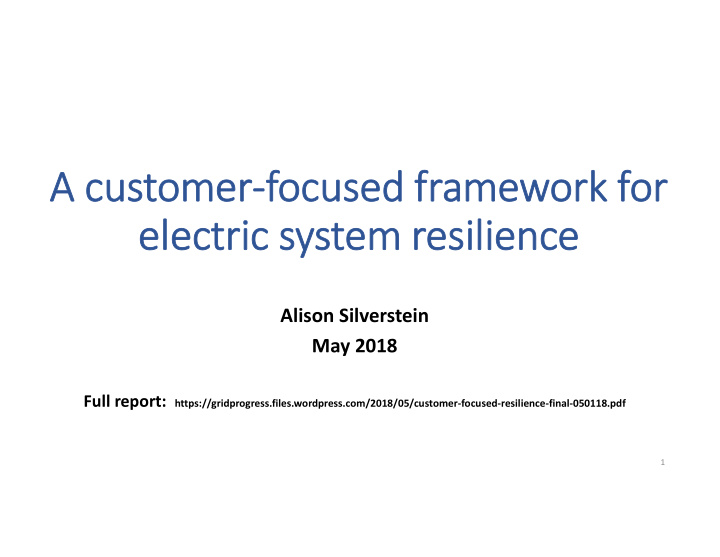



A cus custom omer er ‐ fo focused fr fram amework fo for el electric ectric sy system resilie silience Alison Silverstein May 2018 Full report: https://gridprogress.files.wordpress.com/2018/05/customer ‐ focused ‐ resilience ‐ final ‐ 050118.pdf 1
Relia liability ility and and resilie silience ce ar are insepar separable ble • Reliability and resilience are so deeply intertwined that they are functionally inseparable. • Reliability = operational security (short term) and resource adequacy (long ‐ term) • Resilience = “the ability to withstand and reduce the magnitude and/or duration of disruptive events, which includes the capability to anticipate, absorb, adapt to and/or rapidly recover from an event.” (162 FERC ¶61,012) – up to and after the outage occurs • Many resiliency measures enhance reliability (and vice versa). • In practice, FERC, NERC and RCs have been doing BPS resilience under the reliability umbrella – so we must continue treating reliability and resilience as joint in effort and outcome. 2
Wh What at’s the the go goal al? What’s the problem we’re trying to solve? • Resilience and reliability for generation is different from the grid is different from resilience and reliability from customers’ perspective. • We should prioritize reliability and resilience (R&R) for customers, not just for generation • Customer ‐ centric benchmarks for R&R are: • Outage frequency • Outage duration • Outage magnitude • Outage survivability 3
Ke Key poi points ts about about po power sy system out outages 1) Most outages are caused by distribution ‐ level problems (94%), not generation or Major disaster events are getting worse over fuel supply (way below 1%), and by time routine rather than huge events 2) Major disasters harm transmission, generation or fuel as they harm distribution 3) Some threats are increasing: routine and severe weather, cyber & physical attack. Some are being addressed: GMD, EMP, new surprises… 4) Some questions related to the evolving fuel mix are being studied through standard reliability assessments of grid Source: NOAA 2018 changes: fuel security, loss of inertia, risks and opportunities of DERs and microgrids 4
Thr Threat ‐ agnos agnostic ic me meas asur ures es to to im improve R&R R&R 5
How How to to ev evaluate uate R&R R&R me measures? • Estimate the impact of each measure’s ability to reduce the probability or level of outage frequency, magnitude and duration or upon its ability to improve customer survivability. • Adjust the cost of the measure to reflect its co ‐ benefits (if any) beyond R&R impacts – e.g., T&D O&M has system capital and efficiency benefits, energy efficiency has customer bill ‐ saving, comfort and emissions benefits. • Then calculate dollar per R&R impact. [yes, these would not be easy to estimate but it’s worth thinking about…] 6
Con Context fo for R&R R&R co cost sts • Society, customers and utilities have limited budgets for energy. R&R expenditures for electricity have an opportunity cost – if we increase total electric costs for R&R, customers can afford less electricity, or R&R crowds out other electricity inputs (including other effective R&R measures). • We currently plan for reliability on a deterministic basis (N ‐ 1), and make reliability standards mandatory – i.e., reliability has infinite value. • But many R&R measures have diminishing marginal returns (particularly incremental generation capacity above a reasonable G + DR + EE + storage reserve margin). • So we should look for the set of R&R measures that offer the biggest customer ‐ centric R&R and survivability impact per $, not just look at the measures that are within your jurisdiction. 7
Hi High gh and and lo low va value R&R R&R mea measur ures es: 8
Cus Custom omer er ‐ cen centric ric R&R R&R va value • If most outages arise from routine distribution and transmission events, then R&R measures that address T&D will benefit customers more immediately than resilience for generation. • R&R and survivability measures that are effective against multiple high ‐ probability threats (such as tree ‐ trimming, O&M, energy efficiency, critical spares, smart DG inverters) will benefit customers more, and more often, than measures that address narrow ‐ scope, low ‐ probability threats. • Other high ‐ value R&R measures – physical & cyber ‐ security, mutual assistance, distributed gen & storage, emergency drills, T&D automation, some T&D hardening, elec ‐ gas coordination. 9
Recommend
More recommend